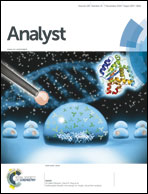An electrochemical impedance sensor based on a small molecule modified Au electrode for the recognition of a trinucleotide repeat†
Abstract
A small molecule modified sensor was developed for the detection of XGG trinucleotide repeats (X = C, T) by electrochemical impedance spectroscopy. The sensor (NCD/MPA/Au) was fabricated by immobilizing the nucleic acid recognition molecule (NCD) on the surface of a gold electrode through a condensation reaction between the amino-terminal end of the NCD linker and carboxylic groups in 3-mercaptopropionic acid that were self-assembled on the electrode surface. After the sensor was incubated with trinucleotide repeats, electrochemical impedance spectroscopy was performed using [Fe(CN)6]3−/4− as redox marker ions. XGG repeats (X = C, T) could be selectively detected based on the differences in charge transfer resistance (ΔRct) even in the presence of other trinucleotide repeats. The relationship between ΔRct and lg [concentration of CGG repeats] for the sensor was linear from 1 nM to 1 μM, enabling the quantification of the number of repeats. The electrochemical impedance sensor provides a simple and rapid method to detect trinucleotide repeats without requiring labelling and immobilizations of DNA, making it promising for the early diagnosis of neurodegenerative diseases; the sensor may be further extended to the detection of other special sequences of DNA.


 Please wait while we load your content...
Please wait while we load your content...